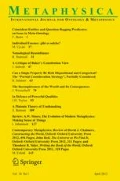Abstract
This paper is concerned with the expressivist account of moral supervenience that Simon Blackburn has offered. First, the account is presented, and an objection to it is thereafter discussed. In short, the objection is that the supervenience constraint in moral discourse is mysterious, given that no similar constraint governs speech and thought in other areas of discourse that seem to be prime candidates for an expressivist analysis. The conclusion of the paper is that this objection can be fended off.
Similar content being viewed by others
Notes
See Klagge (1988).
It is not easy to give a definition of what an intrinsic property is. To get an overview of some of the problems involved in this, see Brian Weatherson’s excellent survey article “Intrinsic vs. Extrinsic Properties” on the Stanford Encyclopedia of Philosophy.
In private correspondence, Nick Zangwill has expressed skepticism about the plausibility of this reply. The reason for this skepticism is the following: the fact that we can judge evaluatively differently in the two non-moral cases because of extrinsic differences in the objects evaluated does not “help Blackburn show that the moral projectivist should judge similarly given natural similarities. The point of the disanalogies was just to point to cases where the projective picture holds without the supervenience requirement. That the analogies are no good if you are right (and I do not pursue that) does not help explain the requirement in moral judgment.” Let me just briefly respond to this line of thought. Firstly, I disagree that the examples are cases where the projective picture holds without the supervenience requirement. As I have tried to argue, the supervenience requirement is in place and supervenience is not broken in the funny/niceness examples. Secondly, Blackburn has offered a reason as to why the supervenience requirement holds in moral discourse (moral judgments could not fulfill their semantic role if they were not disciplined by supervenience). Of course, this might be a bad reason/explanation for the supervenience requirement, but nothing in Zangwill’s example gives us reason to reject the explanation.
Wright (1985:316) has argued against a constraint to the effect that a subvening judgment can only involve reference to properties that can be multiply instantiated. This argument is also based upon considerations about supervenience in aesthetical discourse.
Admittedly, this is controversial. ‘Anti-formalists’ in aesthetics, such as Currie (1989), hold the view that it is possible for artworks to differ in aesthetic value if they are indiscernible in terms of intrinsic non-aesthetical properties. ‘Formalists’ deny this. For more on this issue, see Zangwill (2001).
I would like to thank John Heil and Nick Zangwill for kind and very helpful comments on an earlier version of this paper.
References
Blackburn, S. 1984: Spreading the Word. Oxford: Oxford University Press.
Blackburn, S. 1985: “Supervenience Revisited”. Hacking, I. (ed.). Exercises in Analysis. Cambridge: Cambridge University Press.
Currie, G. 1989: The Ontology of Art. London: Macmillan.
Heil, J. 1998: “Supervenience Deconstructed”. European Journal of Philosophy 6 2, 146–155.
Horgan, T. 1982: “Supervenience and Microphysics”. Pacific Philosophical Quarterly, 63, 29–43.
Kim, J. 1987: ‘“Strong” and “Global” Supervenience Revisited’. Reprinted in Kim 1993, Supervenience and Mind. Cambridge University Press.
Klagge, J. 1988: “Supervenience: Ontological and Ascriptive”. Australasian Journal of Philosophy, Vol. 66 number 4.
Lewis, D. 1983: “Extrinsic Properties”. Philosophical Studies 44.
Wright, C. 1985: “Review of Spreading the Word”. Mind 94, 310–19.
Zangwill, N. 1995: “Moral Supervenience”. Midwest Studies in Philosophy, XX.
Zangwill, N. 2001: The Metaphysics of Beauty. Ithaca: Cornell University Press.
Author information
Authors and Affiliations
Corresponding author
About this article
Cite this article
Sonderholm, J. Does Blackburn’s Expressivism Have a Problem with Respect to Supervenience? A Reply to Wright and Zangwill. Int Ontology Metaphysics 10, 89–95 (2009). https://doi.org/10.1007/s12133-008-0041-z
Received:
Revised:
Accepted:
Published:
Issue Date:
DOI: https://doi.org/10.1007/s12133-008-0041-z


